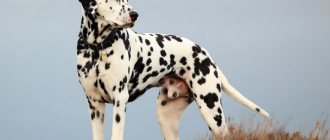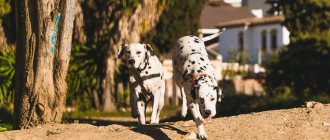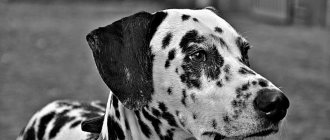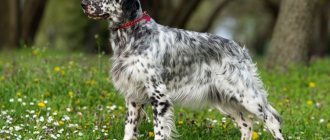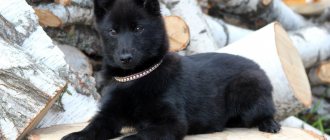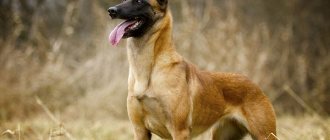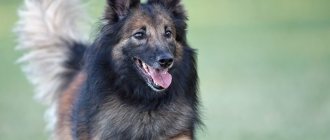| Origin | Croatia |
| Usage | hunter, companion, family dog |
| Color | spotted |
| Dimensions | height 54-62 cm, weight 24-32 kg |
| Lifespan | 11-13 years old |
The Dalmatian is one of the most famous breeds in the world. This is a charming dog with a memorable appearance - smart and loyal. There are negative reviews on the Internet about the intelligence of these animals. However, this is due to improper upbringing - a responsible owner with a strong character will have a pet that will grow up obedient and very loyal.
Description of the Dalmatian breed
Popularity 207th place among 263 dog breeds
Lifespan:
11-13 years old
Height:
males: 56-62 cm, females: 54-60 cm
Country of origin:
Croatia
Average price:
15-20 thousand rubles
Weight:
males: 27-32 kg, females: 24-29 kg
Latest articles Cat health
Rabies vaccination for cats: choice of vaccine, necessity, schedule 01/22/2022 4 0 0
Selection and adaptation
TOP 20 best cat breeds for families with children 01/22/2022 25 0 0
Mating, pregnancy and childbirth
Experts do not recommend breeding a Dalmatian Dog during the female's first heat. Ideally wait for the third one. Moreover, this cannot be done on any day; it is better to introduce the dogs a week or two after the start of estrus. You don’t need to feed them before this, but you do need to take them for a walk. Moreover, the dog and the bitch should spend time together and get used to each other. And then they themselves will figure out what to do next. After a day, a maximum of two are advised to carry out a control mating.
Pregnancy becomes noticeable after about five weeks. The dog may show signs of toxicosis. She will become calmer and more affectionate. Delivery usually occurs after 65-70 days. The Dalmatian breeds a large number of offspring, with an average of 10-14 puppies. Moreover, they are all very viable.
Offspring
Advantages and disadvantages
- Pros:
- kind, easily find a common language with others;
- inexhaustible energy guarantees long walks, 10 minutes is not enough;
- easy to train, but it is better to start from puppyhood;
- clean, do not require frequent bathing - 2-3 times a week;
- love children - older than preschool age.
- Minuses:
- the older the animal, the more stubborn it becomes and strives for independence;
- the dog has a high risk of developing allergies;
- do not tolerate low temperatures well;
- intense shedding.
Vaccination
Up to two months, a Dalmatian puppy is protected by immunity transmitted from its mother. However, it does not protect the baby from all diseases, so it is better not to walk him outside before vaccination.
Only a completely healthy puppy can be vaccinated. Therefore, before the procedure, it is necessary to ensure his health and carry out deworming.
It is recommended to contact a veterinarian for vaccination, but you can do it yourself.
Dalmatian puppy vaccination scheme:
- At approximately 2–2.5 months, the first plague vaccination is given.
- After 10 days, prevention of enteritis, hepatitis, and adenovirus infection is carried out. This procedure is repeated after two weeks.
Injections are given intramuscularly into the thigh. You need to repeat the course of vaccinations after a complete change of dentition. Then once a year you should do disease prevention.
After vaccination, you need to monitor the puppy so that he does not become hypothermic. You cannot bathe your baby until the quarantine period has passed. Often after vaccinations, puppies experience temporary lethargy and decreased appetite.
Key facts
Dalmatians are one of the few breeds that have had to endure difficulties due to the surge in popularity and worldwide fame. This is because not everyone reads the description of the Dalmatian breed: captivated by the interesting appearance of the dog, inexperienced breeders miss the most important thing.
The character of Dalmatians leaves much to be desired, add to this the need for constant activity and physical activity - this breed is suitable for strong owners who are ready for difficulties. By approaching the choice and raising of a puppy seriously, you will see that the Dalmatian will become your best friend and devoted pet - in the best traditions of Disney cartoons.
Keeping Dalmatians in an apartment is difficult - the dogs are large and prefer active leisure time with access to a large space. Therefore, this breed is not for calm owners leading a passive lifestyle; Dalmatians are not suitable for families with small children.
The color of Dalmatians is varied, but only pets with a charcoal or dark chocolate spotted pattern are accepted into dog shows. By the way: the spots on the skin of each dog are unique - like human fingerprints. The characteristics of the Dalmatian breed always emphasize this fact.
The life expectancy of Dalmatians can reach 13 years, but only with good care and concern for the health of the pet.
Popular nicknames for Dalmatians
It is important to choose a nickname for your pet. The name indicated in the pedigree is often long and difficult to pronounce, and it is used only for competitions and exhibitions. You need to name your Dalmatian so that the nickname is euphonious, does not irritate the pet and determines its character or intellectual qualities.
But you can look for a list of the most original names for Dalmatian puppies.
Puppy girl
Suitable nicknames for girls' Dalmatian dogs are:
- Anabel, Assol, Athena;
- Bonya, Barbie, Britney;
- Vanilla, Freckle, Vivienne;
- Gerda, Gloria, Goldie;
- Daphne, Daisy, Dolly;
- Josie, Zhuzha, Zhulya;
- Knopa, Khaleesi, Candy;
- Leia, Loki, Luna;
- Martha, Melanie, Molly;
- Nice, Nuri;
- Oxy, Olivia, Olive;
- Patricia, Prada;
- Riana, Rosie, Ruta;
- Sakura, Stasi, Stella;
- Terry, Tiffany, Tusya;
- Whitney, Una;
- Cherry, Chupa;
- Chanel, Sherry;
- Electra, Elsa, Angel.
Boy
Nicknames for boys Dalmatian dogs:
- Diamond, Aramis, Archie;
- Byron, Bucks, Bond;
- Vegas, Volt, Vulcan;
- Gunya, Goofy;
- Dante, Dario, Dolce;
- Zeus, Zephyr, Zidane;
- King, Compass, Cube;
- Like, Lord, Lotus;
- Michael, Mozart, Mason;
- Nick, Nels;
- Olympus, Oscar;
- Pepper, Pixel, Prince;
- Ralph, Richard, Romeo;
- Sky, Sparky, Snickers;
- Timmy, Timati, Toby;
- Chips, Chupa;
- Eclair.
History of the origin of the Dalmatian
They wrote about Dalmatians long before our times. The breed was mentioned in the ancient scrolls of great Egypt, documents from various eras and more. The description leaves much to be desired, which makes it difficult to compile a complete history of the ancestors of the Dalmatians.
A clearer picture of the origin of the breed emerges from the sixteenth to seventeenth centuries. Then the following were created: the altar in the Church of St. Mary, located in the town of Lošinj (“Gospe od anđela”) - it is painted with the image of dogs with spotted skins; a similar fresco was also discovered in the Church of Santa Maria Novella in Zaostrog. Dogs similar to Dalmatians were also depicted in portraits of dukes and pompous nobles: for example, in one of the portraits Cosimo de Medici is depicted with a dog that looks like a Dalmatian.
Most of the references to Dalmatians are found in Dalmatia (now called Croatia), a similar name and geographical location became the basis for its official consolidation at the official level of the FCI.
In the archives of the Roman Catholic Archdiocese of Djakovo-Osijek, there are records of Bishop Petar Bakic (1719) and Andreas Kecskemeta (1739), which mention a breed different from the usual Croatian dogs Canis Dalmaticus.
1771 - Wales Thomas publishes the book "Synopsis of Quadrupeds". In his book there is the first official mention of the Dalmatian breed.
1790 - Thomas Bewick, exploring natural history, based on the collected materials, decided to include Dalmatians in the “General History of Quadrupeds”.
Dalmatians are especially loved in the vastness of Foggy Albion. Based on the research, a theory was put forward - the breed, which originated from Dalmatia, was crossed with white English terriers and black pointers. Thus, in the eighteenth century, the Dalmatian species known today originated in Great Britain.
The British themselves called Dalmatians “Italian dogs” and identified an interesting feature in them - this breed did not get tired when running, was able to cover long distances at high speed and not give up ground even to fleet-footed horses.
The unique abilities of Dalmatians have found application in the protection of carts, things, and valuable property. They were periodically used to drive horse-drawn carts - the dogs would bite the horses' legs if they slowed down on the way. Frequently accompanying carriages gave Dalmatians the image of carriage dogs.
This breed was a frequent companion of hunters and was popular among court ladies as a faithful protector. Over time, Dalmatians became a sign of luxury and wealth of the owner, which is why they increasingly appeared in portraits of high-ranking rulers.
Having changed their usual habitat, Dalmatians found a calling in the ranks of the fire brigade - they served as a signal, since their bright appearance, noticeable over long distances, began to be associated with the approach of firefighters. Nowadays, this breed has firmly established associations with fire brigades in the United States.
The dogs' colorful exhibition career dates back to 1860 and began in the city of Birmingham, when noble Dalmatians showed themselves to a strict jury. Already in the 1890s, standards for exhibition parameters of the breed were established, recognized by the American Kennel Club. Only the FCI in 1926 documented Dalmatians as a breed.
In Russia, spotted beauties were not so popular. The first appearance was in Moscow in 1982, then few people knew about them, and breeding was irrelevant. In some cities, clubs dedicated to Dalmatians arose, but only in the early 90s.
Nutrition
After the puppy gets to a new home, its diet remains the same for a week. Therefore, when purchasing, you need to ask what products he has already become familiar with. Up to three months, the baby eats 5-6 times a day. The dog is growing rapidly and the number of feedings is gradually decreasing. As the Dalmatian approaches one year of age, he eats twice – in the morning and in the evening.
The Dalmatian's diet should be varied and balanced. It is necessary to determine what exactly the dog will eat - natural food or special food for puppies.
In the first case, the following products are desirable in the pet’s menu:
- meat and fish, excluding fatty varieties;
- vegetables;
- fruits;
- porridge, except semolina, corn and pearl barley;
- eggs;
- cottage cheese.
Appearance of a Dalmatian
General impression
The Dalmatian is an elegant, sophisticated dog with remarkable endurance and the ability to develop great speed. From the photo of the Dalmatian, you can guess that it was once used for hunting.
Head
The ears are located at a short distance from each other. The shape of the head is elongated, flat, with a noticeable stop, and its parameters are directly proportional to the size of the body.
The ears are spotted, like the Dalmatian itself, of medium size, standard triangular in shape, only slightly rounded at the tips. They are adjacent to the head, placed at a distance from each other.
The color of the eyes depends on the color of the dog: dark chocolate in dogs with black spots on the skin, a mixture of yellow-brown is characteristic of Dalmatians with brown spots. Oval in shape, small in size.
Neck
Elongated, muscular.
Frame
Volumetric chest, broad strong shoulders, athletic build. Smooth back. A slight tilt in the lower back.
Limbs
The elbow bend of the front legs is adjacent to the body. The hind legs are strong, designed for running, and the jumping apparatus is well developed. Paws are rounded and collected. The claws are strong, sharp, the color depends on the color of the animal.
Tail
Long, covered in spots, like the dog's entire body. Wide at the base and narrow at the end.
Wool
Smooth, shiny. Quite short in length, close to the body.
Color
There is only one color allowed for a Dalmatian: spotted. On the pure white coat there are clear spots of the same color - black or brown.
Dimensions
The size of the Dalmatian is quite large, which makes you think about the possibility of keeping it in a cramped apartment. The height of the Dalmatian is 60 cm, and the dog looks sophisticated. The weight of a Dalmatian is around 30 kg for males and 25 kg for females.
How to check your pet's health yourself
It is necessary, among other things, to determine whether the animal has a hernia. This procedure is easily performed with the pet resting on its hind legs in a standing position. A hernia can be felt as a bulge in the belly button. It is worth paying attention to the movements of the little Dalmatian: are there any X-shaped hind limbs, club feet, what is the stance of the paws. It is possible that such symptoms will disappear in the future, but one should not hope for this.
It is easier to test your puppy's hearing when he is sleeping. He should immediately wake up from the sudden noise. And if we are talking about a awake puppy, then his reaction will be in the form of pressing his ears or turning his head.
A fault is the color of a pale yellow, peach or lemon shade, the addition of a third color. However, there are no identically colored Dalmatians. A dog's pattern is as individual and unique as a person's fingerprints.
Look at how the eyelids are rimmed. If an adult has a border gap of more than 3 mm, it is discarded. In a 1.5-month-old puppy, this gap should be alarming, in particular if the pigmentation of the coat and the tip of the nose is normal.
Note. At 3 weeks, it is possible to identify a puppy whose nose and eyelid edging are staining more slowly than others (non-staining of 5% or less of the area of the tip of the nose and a tear of the eyelid border of 5 mm or less is not considered a disqualifying defect). However, if such a defect does not improve with age, the dog can be culled.
The entire tip of the nose should be pigmented. So, in Dalmatians with brown spots, the lobe is brown, if there are black spots, the lobe is the same. It is worth considering: the pigmentation of brown puppies develops somewhat more slowly.
By the way, Dalmatian puppies are born without spots and white. At approximately 1.5-2 months, the color completes its formation, but individual spots can appear within 6 months from birth. Over time, nearby spots can merge and grow.
At 2 months of age, the Dalmatian begins to develop character traits. It is easy to notice whether the puppy is active or calm, with what desire he participates in the game or whether laziness prevails.
Dalmatian character
This breed is suitable for owners leading an active lifestyle. For those who like to spend the weekend on the couch in front of the TV, active Dalmatians will bring nothing but inconvenience - they require physical activity, long walks, and are endowed with a complex and capricious character.
Some are of the opinion that Dalmatians are dogs of small intelligence, which is a mistake. In fact, wayward animals simply do not want to obey the owner, ignoring his commands - this is the result of omissions in raising the pet.
Therefore, competent training, education from childhood and socialization are extremely important - the basis of a healthy dog’s psyche. With the right approach, the Dalmatian grows up to be understanding, obedient and friendly. Such a pet will not show aggression towards people around them and other animals; it will obey its owner and not be willful.
They are devoted not only to their owner, but to his entire family. They easily find a common language with other pets, strive to help their household, and take care of them.
Despite the fact that the inhabitants of Foggy Albion nicknamed Dalmatians with the cute nickname “plum pudding”, it is not recommended for families with children to purchase them. Untamed by nature and quite powerful animals can miscalculate their strength and harm a child: knock him down, bite him, carelessly defend himself out of fear of loud sounds.
It is better to get a Dalmatian when the children are older - dogs quickly find a common language with teenagers. The endless energy of both friends is a perfect match.
Grooming
Although the dog's fur is short, it sheds constantly. Puppies move quickly around the house, so tufts of hair quickly spread throughout the apartment. It is better to comb the animals daily. A medium-hard brush will do. A soft one will not cope with the task, and aggressive scratching can damage your pet’s skin.
You won't need to wash your puppy often. After all, even during a walk he behaves carefully, avoids puddles and does not jump into the mud.
Note! A Dalmatian puppy is a clean dog, which greatly simplifies the owner’s task when caring for him.
Education and training
If you want to get an obedient pet, you need to start raising and training a Dalmatian from an early age - the complex nature of the dog can find a way out in chaotic behavior and complete ignorance of the owner due to improper training.
As soon as a little Dalmatian appears in the house, you should immediately take up his education, but without the use of physical violence and strict methods. The child must know what can and cannot be done and what consequences this may have.
After vaccination, you can begin an active socialization program for the puppy - introducing him to other animals, visiting exhibitions, walking in crowded places, training with a dog handler.
Proper education by the age of six months will give the first result - knowledge and execution of a set of not only basic, but also more complex commands. What could be cuter than a little spotted puppy diligently trying to follow commands to lift the spirits of those around him?
Looking for a Dalmatian? Find your pet from 1 offer As a gift
Prices for puppies
Prices for Dalmatian puppies are individual. They are influenced by:
- parental merits;
- expenses for veterinary care;
- costs of keeping the animal.
If his parents are champions, then the cost of the party is very high. However, Dalmatians with excellent pedigree are mainly purchased for breeding or exhibition. A person who wants to buy a dog should know that the price for excellent puppies cannot be low. A low cost may indicate a low-quality pet.
By purchasing a Dalmatian for himself, a person buys himself at the same time an active, reliable, cheerful friend and a guard dog. This animal is a real hunter who will not let its owner get bored.
Dalmatian Health and Diseases
Possible diseases
The average lifespan of Dalmatians is 10-13 years. This is not very much, but with proper care the dog can live longer.
Diseases of the spotted beauty:
- The most common disease of Dalmatians is deafness. Almost a third of all dogs of this breed are susceptible to it, more than 10% are already born deaf. Even healthy dogs can produce puppies with the disease. Deafness is determined by conducting a variety of tests shortly after the baby is born.
- Allergy.
- Improper tissue development.
- Problems with the hip joints.
- Epilepsy.
- Liver disease.
- Shoulder osteochondrosis.
- Osteomyelitis.
Most diseases are inherited, which makes it possible to predict the occurrence of some ailments. To do this, you will have to study the puppy’s passport and monitor its pedigree.
Reproductive health
The female's estrus usually occurs in spring and autumn, that is, it occurs twice a year. Do not rush to breed your girl at the first oestrus - it is better to wait until the second or third heat. Consult your veterinarian about this.
Since there are many problems with the offspring of Dalmatians (congenital deafness and other anomalies), those who are not ready for the harsh everyday life of dog breeding are better off not breeding the bitch or even sterilizing her. This is done in the interval between the first and second or third estrus.
What is it sick with?
The most sensitive areas and organs of Dalmatians include the kidneys and skin. They often develop urolithiasis. The first symptoms are pain in the lumbar region; the dog experiences difficulty when he wants to lie down or stand up, or when jumping. Kidney problems are reflected in the skin, which becomes bronze. In this case, abscesses, bald patches, and allergic reactions appear on it. In 12% of cases, dogs of this breed are born deaf. Dalmatians may suffer from:
- hip dysplasia;
- gastric volvulus;
- glaucoma and progressive retinal atrophy.
Features of feeding and diet
You should control the portion size of the Dalmatian - he sweeps away food at a time, just have time to feed it. But this eating behavior is fraught with obesity, so be strict in this regard.
Adults need to be fed 2-3 times a day, puppies require more food - up to 5 times, but with smaller portions.
It is recommended to establish a feeding schedule: feed in the morning, afternoon and evening at the same time. Thanks to their high intelligence, Dalmatians quickly get used to the regime.
A traditional diet is the best choice for dog owners. It can be based on both high quality dry food and natural products.
Essential foods in a Dalmatian's diet:
- poultry, beef, rabbit, turkey. Does not accept minced meat or fatty meat.
- sea fish;
- eggs two to three times a week
- porridge;
- dairy and fermented milk products;
- various types of vegetable oils;
- fish fat;
- fruits and vegetables;
- berries.
The following foods should be excluded from the diet:
- confectionery;
- sausages;
- seasonings;
- salty;
- tubular bones.
Remember to change clean water frequently and keep it readily available. Sometimes you need to place 2-3 bowls of water around the house.
Description and characteristics of newborn puppies
A newborn Dalmatian puppy weighs 350–450 grams. In the first days of their life, babies do not see or hear anything, and cannot control their body temperature. They receive milk and warmth from their mother. At first, the puppies only sleep and eat.
After two weeks, their eyes and ears open and they try to stand on their paws. When there is not enough mother's milk for all the puppies, breeders begin supplementary feeding. The kittens get acquainted with new food and learn to feed themselves.
When they are a month old, puppies try to run and play with their brothers and sisters. At this age they are 10 times larger than at birth.
When do spots appear on puppies?
A Dalmatian puppy is born with a snow-white color. Spots on representatives of this breed begin to appear after about 7–10 days. They are easily visible on the puppy's white fur.
By the age of two months, the spots become even darker and more expressive. They grow along with the puppy's body, acquiring an increasingly rich color.
Dalmatians do not always have black spots. Some representatives of the breed have a white-brown color, which is also the norm.
Care and maintenance
Dalmatians are not apartment pets. They need space. The best option is to keep your dog outside the city, where there is plenty of space for physical activity and walks. It is possible to keep it in a spacious enclosure, but not for a long time. During the cold season, Dalmatians must be moved to a heated room - short fur will not protect the animal from low temperatures.
Owners who keep a restless pet in an apartment will often have to go on long, hour-long walks filled with a variety of physical activities. Taking your pet for a run or a bike ride is a good way to satisfy your Dalmatian's need for activity.
The ease of caring for and maintaining a Dalmatian is an advantage of this dog breed:
- the fur does not fall into tangles;
- no need for haircut;
- rare water procedures;
- heavy shedding requires frequent brushing, but when the pet does not shed, you can carry out the procedure once a week.
It is worth regularly keeping your teeth, ears and eyes clean, and getting rid of parasites. Deworming is necessary before vaccination, and also once a quarter as a preventive measure.
Dalmatians do not need grooming - except before a show. The owner can handle the rest of the procedures himself.
Dalmatian or Dalmatian: which is correct?
Many dog breeders are interested in the correct name of the breed – Dalmatian or Dalmatian. There are different names in literature and everyday life, which causes confusion.
To find the answer, we must look to history. The pets were named after the historical region of Dalmatia (Balkan Peninsula). Later the dogs were registered under the name "Dalmatian".
The confusion began after the release of Walt Disney's 101 Dalmatians. Then the breed became super popular and people forgot what to call the animals - Dalmatian or Dalmatian.
The breed can also be found under the following names:
- Dalmatian or Dalmatian Dogo;
- Bengal brakk;
- Danish hound;
- harlequin;
- French dog.
Fans mistakenly call these pets “Dolmatian” or “Dolmatian”.
Tips for choosing a puppy
Before going to a nursery or breeder, read reviews on the Internet, study groups on social networks - this is accessible in the age of information technology.
In advance you can see how well the breeders are doing:
- Is the room clean?
- what kind of enclosures the dogs are kept in;
- what Dalmatian puppies and their parents look like;
- What is the attitude of the breeder towards his animals?
If you are satisfied with everything, do not delay your trip. Already on the spot, you have to make one of the difficult choices - to understand which puppy is after your heart. You should not look for a Dalmatian in advance, that is, based on photographs or descriptions: without personal acquaintance, the choice usually does not take place.
There are often cases when owners wanted one puppy based on a photo, but chose another puppy on the spot. That's right: you should like the baby's character, and appearance is secondary.
How does a healthy puppy behave?
- he is active and curious;
- the eyes and nose are shiny, the tummy is moderately well-fed;
- it does not emit any unpleasant odors;
- The baby is not shy or aggressive.
It also happens that a puppy chooses its owner. Then all you have to do is accept this gift of fate and take someone who no longer wants to part with you.
How to choose a puppy
The key to a successful purchase is a balanced and carefully thought-out choice of breeder. Only nurseries with an impeccable reputation can guarantee that the new member of your family will be physically healthy and psychologically stable. Since Dalmatian puppies are given to permanent owners no earlier than 10-12 weeks, they have time to undergo the necessary medical examinations and show their character traits.
A good breeder will ask you as many questions as you ask him, because for him, every four-legged baby is not a living commodity, but an individual, so it is important to understand in what family he will live, in what conditions.
And you, in turn, have every right to meet the parents and study their documents, the veterinarian’s report on the puppy’s health condition and the results of the BAER test (Brainstem Auditory Evoked Response) - an electrodiagnostic hearing test.
It is important to see the conditions in which the mother and babies are kept, learn about nutrition and personally communicate with the puppy you like in order to evaluate its ability to make contact with people and adequately respond to the outside world.
How much does a Dalmatian cost?
It is possible to purchase a Dalmatian puppy without proper documents for 4-8 thousand rubles - but this does not guarantee the purity of the blood and the absence of diseases.
The price of Dalmatians from nurseries varies depending on health, external parameters and pedigree. But here the probability of getting a non-purebred animal is minimal.
Dalmatians with a passport, relevant documents and meeting FCI standards cost from 15-20 thousand to 40-50 thousand rubles. They are worth it if you consider puppies as exhibitors with the hope of winning prizes.
To keep a home as an object of love and care, a healthy puppy without the required ideal parameters is sufficient.
Do you like the article? 0
Application
Throughout its history, the Dalmatian breed has served many functions. Dogs guarded carriages and horses, cleared the way for fire crews, hunted game and herded livestock. Nowadays, animals are usually kept as companions. However, you need to find a use for the unbridled energy of these pets. For example, do agility or freestyle with them.
